British Airways Athletics Club: Streets AtoZ Event Instructions
The objective is for each participant to collect a set of letters as a sequence through the alphabet - the winners being judged on the number of letters collected and the time or distance covered.
You need to start and finish at either an entrance to your property or place of work OR the nearest street-sign to that entrance (but note that this doesn't have to be one of your scoring signs). The objective is to collect as many different street-sign initial letters as you can in the shortest time or distance BUT each successive letter must be further down the alphabet.
Participants should get close enough to the street-sign to be able to take a photograph of it without the benefit of zoom. I'm not encouraging zigzagging across busy streets so photographs can be taken from the opposite side of the street. Photographs do not have to be submitted. If you are not taking photographs then you should tap each sign instead. A GPS trail should be submitted with your entry or a list of the streets in the order they were visited plus confirmation of when you got back to your starting position and the distance covered. In addition to street-signs you are also allowed to score a zebra crossing as a "Z" and other light controlled pedestrian crossings as an "X". To count as an "X" the crossing has to have, or be at, traffic lights and must have a button to press (even if this has no real effect on the sequencing of the lights). No other substitutions are permitted.
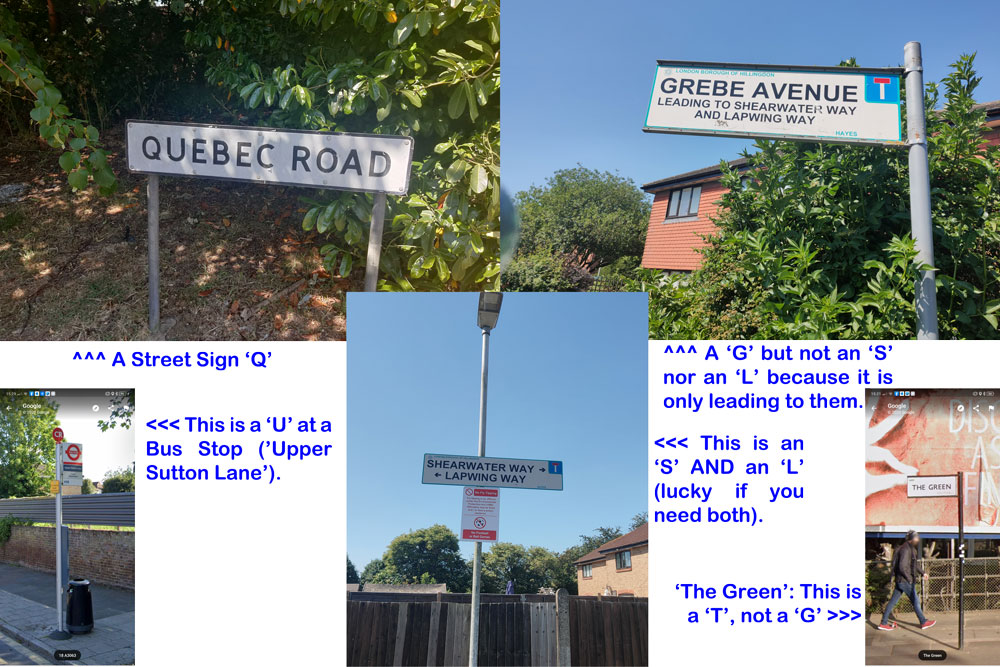
So, just to confirm, you have until the closing date to do your activity and accumulate a set of letters. Email your entry to the organiser including your activity type (run or walk), the distance covered, the time taken, the GPS map and/or the list of streets claimed. Towards the end of the period participants are encouraged to post photographs, GPS trace of their route and comments on the letters collected on Facebook. But it is considered unsporting to post a good result early in the event period. Once all of the results have been verified winners can be announced. Any questions? Contact the organiser: Roderick Hoffman Letter Distribution (for interest only)
Letters marked "*" and "**" are considered rare. |
Judging the Finish Line
This event can be judged on distance, or time, or on each of these. Firstly, considering distance...
The principle is that more letters collected means a better performance and a shorter distance covered for the same number of letters also means a better performance, but a judgment is needed where more letters have been collected over a longer distance.
My immediately neighbourhood has most letters well represented and quite a few of the rarer ones also. There is even a "Q", a "U" and a "Y" at around one mile away. I've done a number of runs and walks in my neighbourhood collecting letters and modified results from these are shown in the graph below. Adjustments have been made to these to reproduce "perfect" scenarios for each of the five cases (for instance I did the 26 as a walk and it included a 500m diversion because an "S" street sign was missing due to an accident; this was deducted and the time for this was estimated using my running pace from recent longer runs). From the points plotted it is obvious that as the number of letters collected increase the average distance covered per letter goes up. This is logical - if it didn't, then one would ask why one hadn't gone to the 'newly' collected letters earlier in the collection runs.

The graph also shows a smoothed line, as generated by Excel, with the equation of that line as "distance = 0.0817 x exp( 0.0728 x distance_per_letter ). This line has been defined as the "Finish Line" for the event. Anyone with results "to the right of and below" this line has finished ahead of me and the person most distant from the line has been adjudged the best. The distance "to the right of and below" has been worked out using Pythagoras.
The attached spreadsheet has the equations to support this calculation encoded in the results table: Results Excel Spreadsheet
The time calculation is similar except that the curve is more pronounced since there is a natural slowing down as one takes on a longer distance run.
The graphs below show the lines in a more digestible format:
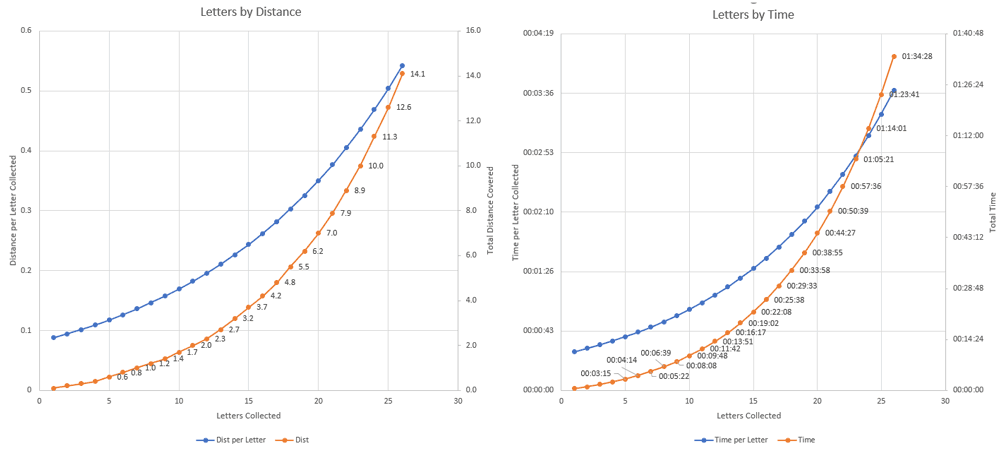

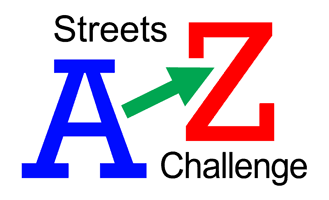 This is a fun competitive event that can be run or walked at
any time during the period specified.
This is a fun competitive event that can be run or walked at
any time during the period specified.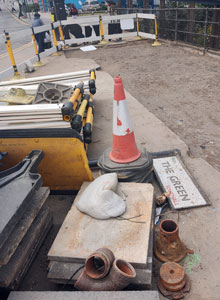 Hint: Roads usually have their street-sign at the two ends of the road or
where the road crosses a bigger road. It can be difficult, or impossible, to
find a street-sign for some bigger roads!
Hint: Roads usually have their street-sign at the two ends of the road or
where the road crosses a bigger road. It can be difficult, or impossible, to
find a street-sign for some bigger roads! 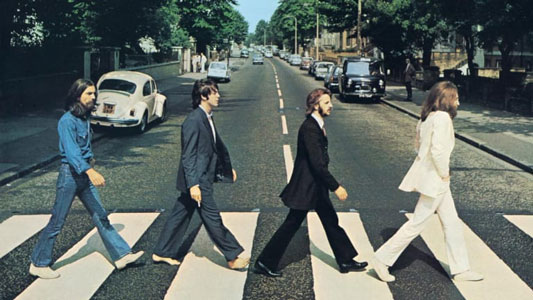 You do not have to start with "A", nor with the letter of the street you
start in. You can start with any letter and precede through the alphabet
skipping letters as you wish. You need to include at least five letters. You do
not have to finish with "Z". There are no letters beyond "Z" (e.g. the alphabet
doesn't repeat). So an example set of length five could be:
You do not have to start with "A", nor with the letter of the street you
start in. You can start with any letter and precede through the alphabet
skipping letters as you wish. You need to include at least five letters. You do
not have to finish with "Z". There are no letters beyond "Z" (e.g. the alphabet
doesn't repeat). So an example set of length five could be: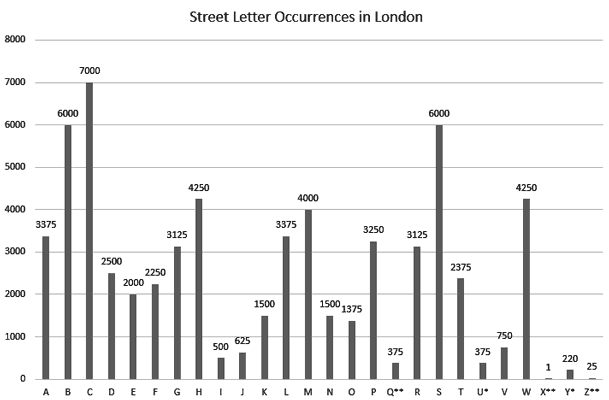 The
chart shows the number of streets in London starting with each letter of the
alphabet. This has been estimated from the street index of a copy of the London
AtoZ.
The
chart shows the number of streets in London starting with each letter of the
alphabet. This has been estimated from the street index of a copy of the London
AtoZ.